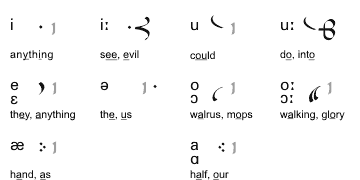This valuation is found in two documents. The first [R22] contains two texts in English, one with barred sarati, the other omitting the bar. The second [R23] is Tolkien’s name written twice.
Probably written some years before the publication of The Hobbit, these are the last longer texts written with Sarati by Tolkien. As such they represent his “last word” on most aspects of the writing system. Not surprisingly, this valuation shows greater kinship with the Tengwar than any other incarnation of the Sarati.
The Late Form uses the consonant signs seen in figure 1. Below each sarat is written a word for which the sarat has been put to use (in either R22 or R23). The Roman letters that correspond to each sarat are underlined. Sarati shown in grey are unattested.
Figure 1: Consonant signs in the Late Form

The Late Form uses diacritics to indicate preceding nasal, adjacent [s], and adjacent [z].
 Preceding nasal is indicated by writing a wavy line on top of
the sarat. The Late Form only attests that the diacritic signifies preceding n
before d and t, but other valuations suggest that it may indicate any
homorganic nasal (that is, n before d or t, m before
b or p, and ng [ŋ] before
g or k.)
The word and is always written as a nasalized d.
Preceding nasal is indicated by writing a wavy line on top of
the sarat. The Late Form only attests that the diacritic signifies preceding n
before d and t, but other valuations suggest that it may indicate any
homorganic nasal (that is, n before d or t, m before
b or p, and ng [ŋ] before
g or k.)
The word and is always written as a nasalized d.
 Adjacent [s] is indicated
by attaching a curl to the sarat. The placement of the curl is rather free,
but attached to the back it is pronounced before the sarat,
and attached to the front it is pronounced afterwards.
Adjacent [s] is indicated
by attaching a curl to the sarat. The placement of the curl is rather free,
but attached to the back it is pronounced before the sarat,
and attached to the front it is pronounced afterwards.
 Adjacent [z] is indicated by two
short, parallel lines attached to the sarat. The same rules for attachment apply
as to the [s] diacritic above.
Adjacent [z] is indicated by two
short, parallel lines attached to the sarat. The same rules for attachment apply
as to the [s] diacritic above.
The vowel diacritics used in the Late Form are seen in figure 2. They are always placed on top of the sarati, except the diacritic for schwa /ə/, which is always placed at the bottom. The vowel is always pronounced before the consonant to which it is attached. An exception to this is the word the, which is consistently written as if the vowel preceded the consonant (allowing the word to be written with just one sarat).
Figure 2: Vowel diacritics in the Late Form

As figure 2 reveals, no symbols are attested for long e, æ, a or the schwa. It may be that none of these are strictly necessary to write English.
Unaccented vowels, in English usually being pronounced as a schwa, are often but inconsistently ignored in Sarati writing. For example, in the sources the word kingdom is always written with a schwa diacritic indicating the pronunciation of the final o, while in the word heaven the last e is systematically omitted.
The short carrier in the Late Form has the shape of a short dash running parallel with the bar line. No long carrier is used.
Using the Late Form as described above, you might write something like the following:

OF THE FASHION OF THE WORLD
About all the World are the Ilurambar, or Walls of the World. They are as ice and glass and steel, being above all imagination of the Children of Earth cold, transparent, and hard.
— Rúmil, The Ambarkanta